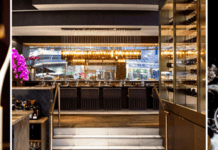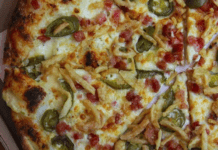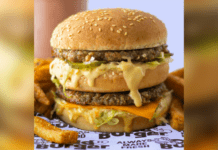The COVID-19 pandemic and subsequent economic crisis has had an undeniable impact on the Canadian foodservice industry. Shutdowns, health-and-safety measures and continued uncertainty have created a challenging environment for operators.
According to Restaurants Canada’s Foodservice Facts 2020, at the height of pandemic shutdowns (April 2020), commercial foodservice sales plummeted by 61.4 per cent compared to the previous year. And, with many Canadians working from home, locations in downtown cores have especially suffered, as has the breakfast daypart. Data from The NPD Group shows that, in April, breakfast traffic at quick-service restaurants (QSRs) fell 48 per cent year over year, while breakfast and lunch traffic at full-service restaurants (FSRs) plummeted more than 80 per cent.
“Before the pandemic [38 per cent] of an average (Canadian) household’s food bill was devoted to foodservice. In March [and] April, it went down to nine per cent,” Sylvain Charlebois, professor of Food, Distribution and Policy at Dalhousie University, stated during the 2020 Terroir Symposium in September. “Now, based on our estimates, we’re at about 75-per-cent [retail], 25-per-cent [foodservice].”
In this environment, Nick Di Donato, president & CEO of Toronto-based Liberty Entertainment Group, says the focus of many has been finding ways to “minimize the losses so we can get through this period.”
“Trying to pivot the business is one thing,” adds Ryan Moreno, CEO of Surrey, B.C.-based Joseph Richard Group (JRG). “But [we were] also trying to figure out, at the same time, what was going to be allowed.”
Despite government support measures and efforts to pivot operations to suit the current climate, a Restaurants Canada survey found the majority of restaurants that were open for just takeout/delivery or on-premise dining were not turning a profit, with 68 per cent of FSRs and 51 per cent of QSRs reporting they were operating at a loss.
Di Donato also points out companies and brands that had poured their resources into expansion prior to the pandemic have been left in a particularly precarious position. “Anybody who was on a rapid-growth curve is going to suffer exponentially,” he says. “They’ve allocated all their resources and funding into expansion and perhaps don’t have as much of a purse to hang on and keep things going.”
As David Hopkins, president, Toronto-based The Fifteen Group, explains, the challenges faced by the industry’s various segments “are pretty much the same across the board.” He highlights reduced traffic, new safety procedures and exacerbated staffing challenges as key examples. “Managing staff, schedules and flow of traffic is always challenging in the best of times,” he explains. “Now it’s become even more of a full-time job just to manage that aspect.”
And, while the entire industry is struggling and working to navigate the challenges created by the pandemic, not all segments of the industry have been impacted equally.
Quick Service and Fast Casual
“The quick-service and fast-casual segments fared better through it all because they could pivot more easily to a delivery/takeout model,” says Hopkins. However, he adds, almost everyone is down compared to last year and the speed with which restaurants were able to shift their operating model and share these changes also impacted performance.
According to Foodservice Facts 2020, while faring better than other segments, QSRs saw declines of 40.6 per cent in April. And, despite largely being well positioned to shift to takeout/delivery, 19 per cent of restaurants in the segment temporarily shut down all operations due to either their business model or location in a shopping mall.
As noted in a Technomic Industry Insights report, pizza chains were among the segment’s best positioned to adapt to the COVID-19 landscape, emerging as the crisis’ “early winners” due to their well-established off-premise channels, including both in-house and third-party delivery. Reflecting this trend, Pizza Hut had systemwide sales growth of 18 per cent during the second quarter of 2020 and a year-to-date increase of 11 per cent.
Other major brands reported significant sales declines, including Burger King and Tim Hortons, which saw Q2 decreases of 25 per cent and 33 per cent respectively. Similarly, A&W Food Services of Canada Inc. reported a 31.6-per-cent drop in same-store sales for Q2. KFC’s Canadian operations were less impacted, reporting a four-per-cent decline.
On the other end of the spectrum, Popeyes Louisiana Kitchen, which has been growing its presence in Canada, posted double-digit system wide sales growth for the quarter (24 per cent).
Aside from declining sales, the factor affecting this segment the most is the growth of contactless ordering. According to Technomic, many Canadian consumers expect these options to be offered at fast-food outlets, with more than 30-per-cent indicating online ordering via mobile or computer is an expectation.
“There’s a lot more movement towards streamlined operations and [fewer] points of contact,” says Hopkins. “Prior to COVID-19, we were starting to see things like self-serve kiosks [rolling out at McDonald’s and Burger King]…And I think we’re going to see that happen a lot faster.”
As an example, he points to Box’d by Paramount, which launched this summer and is touted as a fully automated restaurant experience. Toronto’s Naan & Kabob Group also launched the Cubby Smart Kitchen concept in October, offering five different menus served through a self-serve ‘Cubby’ (digital locker) system.
And, in recent months, Burger King and Starbucks both announced plans to implement new restaurant designs focused on convenience and improving the digital-customer experience in reaction to changing customer behaviours.
Full Service
Generally speaking, FSRs didn’t fare as well as their QSR counterparts. According to Restaurants Canada, the majority of FSRs temporarily closed through April following lockdown because many weren’t well positioned to shift to takeout/delivery operations.
According to Statistics Canada, full-service restaurants saw a 78.1-per-cent year-over-year decline in sales for the month of April. During this time, 47 per cent of restaurants in the segment were closed for the entire month and 65 per cent were closed for at least part of April.
During the height of shutdowns, many, including Liberty Entertainment Group, took the time to assess their options before implementing an off-premise strategy. Its first focus was its casual Italian-food brand Cibo Wine Bar, which already had some delivery presence. “[We] increased the offers we had, did things to make it better [and] we even went into things that were never offered before,” says Di Donato, explaining that Cibo began selling cook-at-home meals.
While JRG also implemented new offerings — including meal and cocktail kits — as it shifted to off-site dining, Moreno says the company found itself in a somewhat more favourable position than some of its competitors, as its portfolio of public houses and upscale-casual restaurants already had established digital-ordering channels. The company had also launched its ghost-kitchen platform, Meal Ticket Brands, in 2019, which Moreno credits with helping get the company through the shutdowns.
“We were extremely lucky we had launched this delivery concept prior [to the pandemic],” he says. “We didn’t have to lay off any of our management across the company…they were the ones, from the front and back of the restaurant, operating the delivery out of our stores.”
Moreno also credits its focus on more suburban locations in the Fraser Valley with helping JRG maintain demand at its restaurants, explaining these locations are more community focused and less reliant on tourism or office/business clientele.
Di Donato points out that, generally, fine-dining restaurants were not well equipped to quickly pivot their operations during shutdown. But, after enhancing Cibo’s delivery offerings, the company began testing delivery for its Blue Blood Steak House. “We weren’t sure it would resonate, because [it’s] high end, very expensive,” he says. But the company was ultimately surprised by its success. “People were getting tired of the same old food and were ready to have a special meal at home, so we filled that gap with Blue Blood.”
“[COVID-19 has] forced a lot of restaurants that were never interested in online ordering [to] all of a sudden start scrambling and looking for a solution,” says Hopkins. “Now, if you don’t have that, you’re behind.”
With the re-opening of on-premise dining, FSRs saw a significant increase in sales (dollars), which grew 58.3 per cent in June from the previous month, according to Statistics Canada. However, the segment’s unadjusted sales for June 2020 were still down 51.8
per cent in year-over-year comparison.
And, with the return of cooler weather, full service is expected to see renewed challenges. “In the table-service [segment], whether it’s upscale-casual, casual-family or high-end dining, we’re going to see price increases over the next little while,” says Hopkins, citing the end of patio season and decreasing government support. “The only way that restaurants with reduced capacity can remain profitable is to increase prices.”
Alternative Channels
Given the current uncertainty and ongoing shifts in consumer behaviour, Charlebois says, “This blurring line we’ve been talking about for many years, between service and retail, is going to become even more interesting…COVID-19 just blew everything up — there’s no line anymore, it’s just food.”
As an example, he points to Loblaws’ recent collaboration with Toronto restaurants for meal-kit offerings, adding he expects to see more initiatives like this in the future. The launch saw Loblaws add dishes from Burger’s Priest, La Carnita, Fresh Restaurants, Fat Lamb Kouzina, General Assembly Pizza, Kinton Ramen and Sala Modern Thai to its PC Chef Meal Kits direct-to-home delivery service.
“Probably the most important thing happening right now is this phenomenon that I call ‘the democratization of the food supply chain’ as a result of COVID-19. Because of e-commerce, everyone has access to the consumer,” adds Charlebois. “We actually are expecting online sales for food to triple this year as a result of the pandemic.”
Many restaurant companies turned to HMR and meal-kit offerings to supplement revenue during the height of pandemic shutdowns. For example, TopTable Group, Oliver & Bonacini and Joey introduced grocery and meal-kit offerings for online ordering and delivery.
Expanding on its cook-at-home offerings, Liberty Entertainment Group launched a boutique grocery concept offering restaurant-quality products direct to consumers, as well as a selection of spirits and wines curated from its restaurants’ wine cellars. “We created a Cibo Market within our [Cibo] restaurants…because we had suppliers, we had food [and] we had the space,” explains Di Donato. “Those did fairly well, helped us get through,” he adds noting the new revenue stream helped mitigate losses.
And, moving forward, Di Donato says the company is eying further moves into e-commerce. “[We plan to] continue looking for things like [Cibo Market], which are restaurant/hospitality related, but can get us outside of just being bricks and mortar.”
Moreno notes “the innovation that we had [done] earlier certainly helped carry us through.” This innovation included an online liquor-delivery platform that had been in the works prior to the pandemic, which JRG was able to accelerate and launch quickly after lockdowns occurred. “We’ll continue to push down that road,” he adds, referring to delivery-focused initiatives within the company.
In September, Toronto-based General Assembly Pizza launched a pizza-subscription service offering free home delivery for stacks of four to 10 pizzas, building on its line of frozen pizzas launched in the spring. While initially available to customers in Toronto, the brand plans to expand the service throughout Ontario in 2021.
And, in October, Toronto-based iQ Foods Co. launched iQ Essentials, offering a new line of ready-to-cook meals and snacks for front-door delivery once a week.
And, while some operators continue to explore and roll out new e-commerce platforms, Moreno says the future of JRG’s meal-kit offerings is “iffy,” noting declining demand as most businesses re-opened. However, “direct to consumer is still something we’re looking at and plan to keep pushing forward,” he adds, highlighting the important role its food- and liquor-delivery platforms have played in the company weathering the pandemic. “The direct-to-consumer [channels], regardless of COVID-19, was something that was coming anyway.”
As Hopkins points out, the HMR and meal-kit market is now highly competitive and has even tighter margins than restaurants. And, with many caterers and restaurants seeing these markets as an opportunity, “that’s extremely challenging,” he says, “because there’s so many people trying to pivot to that.”
Moving Forward
The disruption caused by the pandemic is expected to have a range of far-reaching impacts on the foodservice industry, not the least of which is the growing number of permanent closures. Charlebois says he anticipates approximately 30 per cent of all Canadian foodservice establishments could go out of business “by next year.”
“For a very long time, our industry is going to be a lot more cautious,” says Di Donato. “I don’t think you’re going to see the rapid growth in a lot of areas that you’ve seen before in the food industry — because this could happen again.”
“[The pandemic has] made the consumer a little more empathetic to restaurateurs and the hospitality industry, to understand how difficult our business is,” Di Donato adds. “I also think communities will realize how important our industry is to community.”
Given the level of uncertainty felt within the industry, focus on diversification seems to be on the rise. A prime example, Paramount Fine Foods has launched four new concepts since June as part of its ‘pandemic plan.’ In addition to Box’d, Paramount has launched the Brampton Cloud Kitchen offering pickup and delivery; the fried-chicken concept Krispo Chicken; and MAS.E.MO pizza in partnership with chef Massimo Capra.
And, both Di Donato and Moreno credit their companies’ diversified businesses as an asset that’s helped them weather the current crisis and pointed to further diversification as a key focus going forward. Speaking to the future of delivery and e-commerce
offerings, Charlebois adds, “I don’t think there’s any going back…because people are getting accustomed to the service — and the service is getting better.”

















